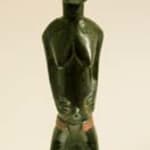Baule Colonial Painted Wooden Sculpture of a Seated Woman, 20th Century CE
Painted Wood
10.4 x 36.8 cm
4 1/8 x 14 1/2 in
4 1/8 x 14 1/2 in
X.0671
Further images
In the early part of the 20th Century, Baule statues reached Europe and caused a stir in the art world. The innovative artists of the time--Picasso, Vlaminck, Brancusi, who were...
In the early part of the 20th Century, Baule statues reached Europe and caused a stir in the art world. The innovative artists of the time--Picasso, Vlaminck, Brancusi, who were already deep in the throes of their own artistic revolution--felt an immediate and profound appreciation for the refinement and economy of line and form typified by Baule statues. The influence of one on the other is clearly visible, and constitutes one of the most interesting periods in modern art history.
This charming statue is a wonderful example of the beautiful craftsmanship that can come out of Africa, and enrich us with its history and its presence. As she sits comfortably on a small stool, she holds her slightly distended belly and looks directly forward. Stools were considered one of the penultimate signs of authority in Africa, suggesting that this woman may be a mother queen. Her breasts are pendulous, showing her femininity and fecundity. Her hair has been braided into a central crest that enhances her beauty and further reveals her high ranking status, since such elaborate coiffures often took hours to complete, employing the skills of one or more stylists. The surface of this sculpture has been painted, telling us that this work was created during the colonial era when modern paints were imported to the continent. Traditionally, such sculptures would have been stained with dark oils and other native materials. Furthermore, the artist has used colored hues to enliven the piece, including a red belt, white eyes, and blue visible on the base.
This charming statue is a wonderful example of the beautiful craftsmanship that can come out of Africa, and enrich us with its history and its presence. As she sits comfortably on a small stool, she holds her slightly distended belly and looks directly forward. Stools were considered one of the penultimate signs of authority in Africa, suggesting that this woman may be a mother queen. Her breasts are pendulous, showing her femininity and fecundity. Her hair has been braided into a central crest that enhances her beauty and further reveals her high ranking status, since such elaborate coiffures often took hours to complete, employing the skills of one or more stylists. The surface of this sculpture has been painted, telling us that this work was created during the colonial era when modern paints were imported to the continent. Traditionally, such sculptures would have been stained with dark oils and other native materials. Furthermore, the artist has used colored hues to enliven the piece, including a red belt, white eyes, and blue visible on the base.







